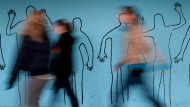E1,800 meters separate Krems from the Heukuppe, the Rax’s highest peak at 2,007 meters. In meters above sea level. So why an exhibition on the beautiful gray-green Danube when it comes to a high-alpine theme? A reflex kicks in that jumps out at our Austrian neighbors when it comes to his property: his world is the mountains. After all, part of the Rax lies in the territory of the federal state of Lower Austria, which also includes Krems. The rest of Vienna’s local mountain belongs to Styria. After all: In Lilienfeld, sixty kilometers south of Krems, the first slalom in the history of skiing took place in 1905, in which Mizzi Langer took part, more about her later.
Since the beginning of the year, the Landesgalerie, the building by the Vorarlberg architects Marte.Marte, which opened in 2019 and enriches the city silhouette without dominating it, has been managed by the art historian Gerda Ridler. Their focus is actually contemporary art after 1945, but there is no stopping the topic “Aufi muas i”: At the opening of the show last weekend, Ridler even let a climber climb the zinc roof of the museum for the first time.
Curator Wolfgang Krug has brought together more than three hundred exhibits, and three dozen lenders, many of them private, have contributed them. The two painter and mountaineer friends who are the focus of the show: Gustav Jahn (1879 to 1919) and Otto Barth (1876 to 1916) are almost non-existent in public collections. Two Viennese who enjoy an excellent reputation in the world of mountaineering, but have so far received little attention in art history. Both died young, Jahn died in a climbing accident, Barth succumbed to an illness that was never properly diagnosed.

Mountaineering as a business: Gustav Jahn illustrated the catalogs of the Viennese sports store Mizzi Langer
:
Image: State Gallery of Lower Austria
Together they have contributed to turning enthusiasm for the mountains into a mass sport, and in this respect the show is a glimpse into the well of history in times when people are considering how to protect the Alps from overtourism. The Rax massif has everything your heart desires – for climbers, mountain hikers and hotel guests in the luxury hotels that were built along the railway. It was the Viennese who excelled in opening up the Eastern Alps, where the Austrian Alpine Club was founded in 1862, the first club of its kind on the continent. And even then, the Rax was considered overcrowded.
Tiny people, monumental peaks
Three more figures are added to the two painters as an imaginary roped party, who were not friends in the narrower sense. There is Fritz Benesch, born in 1868, also a professional mountaineer and photographer. In civilian life, he is a tourism officer in the Ministry of Railways, and he places many orders with Jahn for advertising posters. They can also be seen along with a hundred photographs that Benesch took on his tours: Impressive, timeless interpretations of the tiny human being who, always with his back to the camera, shrinks to a footnote in front of the monumentality of the mountains.
There is the restaurateur and photographer Camillo Kronich from Ottohaus auf der Rax, who skilfully promotes the economization of the mountain world by having hiking trails and via ferrata laid out that always end in front of the door of his huts. And he also organizes the omnibus as a feeder. This is how a tourism empire is created, which the already mentioned Mizzi Langer serves on the outfitter side. A daring skier who rose to become Vienna’s leading specialist retailer in the noughties of the 20th century.
She develops skiing, tobogganing and climbing equipment with the best manufacturers such as Bilgeri and Zdarsky, which she tests herself. Langer-Kauba, as she calls herself after marrying her general manager, builds a stately commercial building on Kaiserstrasse in the seventh district of Vienna. An invoice from 1911 shows that the Highly Born Mrs. Hofrätin von Kreuzburg bought “1 pair of Norwegian rails with Bilgeri binding” for the price of 44 crowns.
Mizzi Langer and her feeling for snow
All of this is informative in terms of cultural history and fits into the pioneering period of mountain tourism, which has been the subject of museums in the Alpine countries for years. The show is made really interesting by the paintings by Jahn and Barth, which have never been seen in this synopsis. Jahn is endlessly diligent. In ten weeks he paints twelve large-format “More and Costumes Pictures”, which are awarded prizes at the 1904 Saint Louis World’s Fair. The cycle is lost except for a copy shown in Krems. Mizzi Langer uses him as an illustrator for her sports catalogues. Seventy of these images are grouped into a large display board. During the First World War, Jahn served as an instruction officer for the mountain guide department in the Dolomites and continued to paint on the side.
Barth developed more artistically, became a member of the Hagenbund, an artists’ association founded three years after the Vienna Secession. His painting “The Deserted Alm” from 1905 is gloomy and melancholic, quite different from his probably best-known picture “Morning Prayer on the Grossglockner” (1911), in which hints of pointillism can already be seen, a hymn to the performance of the human being who is in the cross recognized a higher power. Snow is a technically challenging subject then as it is today, and so not all clouds of snow dust rising up when braking or the ruts on a toboggan run are convincing. Barth’s “Snowy Trees”, on the other hand, shows frozen, bent trees under heavy snow loads, whose fresh snow sugar coating seems almost abstract, as if flour had been dusted over organic dough shapes.
Alpine rope teams. Mountaineering around 1900. Landesgalerie Niederösterreich, Krems: until October 8, 2023. A catalog is in preparation.









